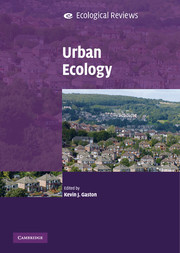Book contents
- Frontmatter
- Contents
- List of contributors
- Preface
- 1 Urban ecology
- 2 Urbanisation
- 3 Urban environments and ecosystem functions
- 4 Individual species and urbanisation
- 5 Species diversity and urbanisation: patterns, drivers and implications
- 6 Urbanisation and alien invasion
- 7 Interactions between people and nature in urban environments
- 8 Urban ecology and human social organisation
- 9 Urban ecology and human health and wellbeing
- 10 Bringing cities alive: the importance of urban green spaces for people and biodiversity
- 11 Integrating nature values in urban planning and design
- 12 Urban futures
- Index
- References
3 - Urban environments and ecosystem functions
Published online by Cambridge University Press: 05 June 2012
- Frontmatter
- Contents
- List of contributors
- Preface
- 1 Urban ecology
- 2 Urbanisation
- 3 Urban environments and ecosystem functions
- 4 Individual species and urbanisation
- 5 Species diversity and urbanisation: patterns, drivers and implications
- 6 Urbanisation and alien invasion
- 7 Interactions between people and nature in urban environments
- 8 Urban ecology and human social organisation
- 9 Urban ecology and human health and wellbeing
- 10 Bringing cities alive: the importance of urban green spaces for people and biodiversity
- 11 Integrating nature values in urban planning and design
- 12 Urban futures
- Index
- References
Summary
Urbanisation profoundly changes both the abiotic and biotic properties of ecosystems. It does so not just within urban areas, but also in surrounding landscapes and often much further afield. Traditionally, the foremost focus for research has been on the negative impacts of these changes, particularly for human health and wellbeing, and how these can most effectively be mitigated. This is readily understandable given that, for much of their history, urban environments have often been associated with high rates of infant mortality, disease outbreaks and a generally poor quality of life, and that this still remains true for many of those living in cities today (Woods 2003; UN-HABITAT 2006; Birchenall 2007). From a broader ecological perspective, urban areas have also long been considered depauperate in comparison to their rural counterparts in terms of flora and fauna, with the exception of a few notable species that were widely categorised as pests.
More recently, research into urban environments has increasingly shifted towards examining the positive contributions that such areas can make both to the human population and to other species. Of course, viewing urban environments in terms of the benefits they can provide or the costs they can exact are essentially two sides of the same coin. However, closer consideration of the potential advantages has served to broaden the range of environmental issues that have received emphasis; rather than focusing almost exclusively on the undoubtedly vital human health concerns resulting from poor air quality, unclean water and inadequate sanitation, there is now a growing appreciation of the benefits that greener and more ecologically diverse urban areas have on the mental and physical status of residents, on economic markets and for biological conservation (Chapters 7–11; Fuller et al. 2010; Gaston & Evans 2010; Irvine et al. 2010).
Information
- Type
- Chapter
- Information
- Urban Ecology , pp. 35 - 52Publisher: Cambridge University PressPrint publication year: 2010
References
Accessibility standard: Unknown
Why this information is here
This section outlines the accessibility features of this content - including support for screen readers, full keyboard navigation and high-contrast display options. This may not be relevant for you.Accessibility Information
- 27
- Cited by
